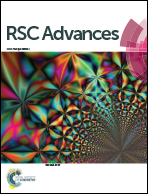Interactions between crystalline nanospheres: comparisons between molecular dynamics simulations and continuum models†
Abstract
Although the breakdown of the continuum model at the nanoscale has been predicted, the origin of failure is not well understood. This in turn has affected our better understanding of interparticle forces. In this work, the interaction forces including the van der Waals (vdW) attraction, Born repulsion and mechanical contact forces between crystalline silicon carbide nanospheres are studied using molecular dynamics (MD) simulations. The origin of the deviation from the Hamaker approach is fully analyzed and ascribed to the underestimated number density of atoms apart from the neglect of atomic discrete structure and surface effects. Two equations have been proposed to describe the vdW attraction and Born repulsion forces between silicon carbide nanospheres. Moreover, MD simulated results confirm that the mechanical contact forces between silicon carbide nanospheres at low compression can be largely described by the Hertz model. Also, the definition of contact at the atomic level when a mechanical contact force initiates at equilibrium separation is validated. Finally, the theory of normal impact between two frictionless elastic bodies is evaluated at the atomic level, which shows that the maximum compression achieved is in semi-quantitative agreement with continuum prediction. The origin of existing quantitative differences is critically studied and the continuum equation is adapted to predict the maximum compression at the nanoscale.


 Please wait while we load your content...
Please wait while we load your content...